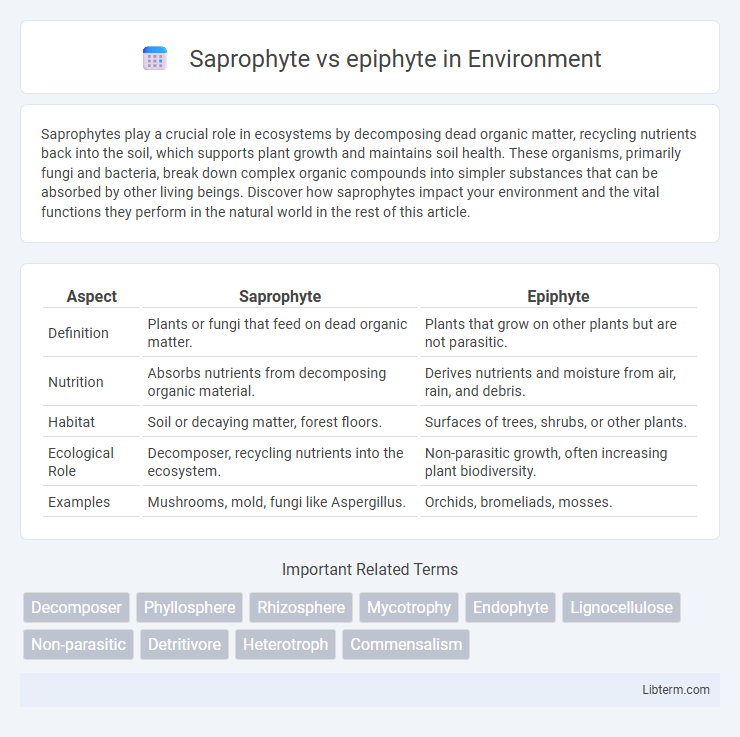Saprophytes play a crucial role in ecosystems by decomposing dead organic matter, recycling nutrients back into the soil, which supports plant growth and maintains soil health. These organisms, primarily fungi and bacteria, break down complex organic compounds into simpler substances that can be absorbed by other living beings. Discover how saprophytes impact your environment and the vital functions they perform in the natural world in the rest of this article.
Table of Comparison
| Aspect | Saprophyte | Epiphyte |
|---|---|---|
| Definition | Plants or fungi that feed on dead organic matter. | Plants that grow on other plants but are not parasitic. |
| Nutrition | Absorbs nutrients from decomposing organic material. | Derives nutrients and moisture from air, rain, and debris. |
| Habitat | Soil or decaying matter, forest floors. | Surfaces of trees, shrubs, or other plants. |
| Ecological Role | Decomposer, recycling nutrients into the ecosystem. | Non-parasitic growth, often increasing plant biodiversity. |
| Examples | Mushrooms, mold, fungi like Aspergillus. | Orchids, bromeliads, mosses. |
Introduction to Saprophytes and Epiphytes
Saprophytes are organisms that obtain nutrients by decomposing dead organic matter, playing a crucial role in nutrient cycling and soil health. Epiphytes, in contrast, grow on other plants for physical support but do not parasitize them, absorbing moisture and nutrients from the air and rain. Both saprophytes and epiphytes exhibit unique adaptations to their environments, with saprophytes thriving in nutrient-rich decaying material and epiphytes adapting to elevated, light-accessible habitats.
Definition of Saprophytes
Saprophytes are organisms that obtain nutrients by decomposing dead organic matter, playing a crucial role in nutrient cycling within ecosystems. Unlike epiphytes, which grow on other plants for physical support without harming the host, saprophytes actively break down complex organic compounds to access energy. This saprotrophic mode of nutrition involves extracellular enzyme secretion that facilitates the degradation of lignin, cellulose, and other organic polymers.
Definition of Epiphytes
Epiphytes are plants that grow on other plants for physical support without extracting nutrients from their hosts, relying instead on air, rain, and debris for sustenance. Unlike saprophytes, which obtain nutrients by decomposing organic matter, epiphytes thrive by absorbing moisture and nutrients directly from their environment. Common examples of epiphytes include orchids, bromeliads, and ferns, which play vital roles in forest ecosystems by providing habitats and contributing to biodiversity.
Key Differences Between Saprophytes and Epiphytes
Saprophytes obtain nutrients by decomposing dead organic matter, primarily fungi and certain bacteria, playing a crucial role in nutrient recycling within ecosystems. Epiphytes grow on other plants non-parasitically, deriving moisture and nutrients from the air, rain, and debris accumulated around them, commonly seen in orchids, ferns, and bromeliads. Unlike saprophytes, epiphytes rely on living host plants for structural support but not for nutritional dependence, highlighting a fundamental ecological and functional divergence.
Habitat and Environmental Preferences
Saprophytes thrive in decaying organic matter such as leaf litter, soil rich in decomposing material, and forest floors with high humidity and low light, enabling efficient nutrient absorption from dead matter. Epiphytes grow on the surface of other plants, primarily trees, in habitats like rainforests where they receive ample moisture and filtered sunlight without rooting in soil, relying on air humidity and rain for water. Both saprophytes and epiphytes adapt to specific microenvironments that provide necessary moisture levels and nutrient access, but saprophytes depend on detritus-rich substrates while epiphytes occupy aerial niches.
Modes of Nutrition: Saprophytic vs Epiphytic
Saprophytes derive nutrients by decomposing dead organic matter, playing a crucial role in nutrient recycling within ecosystems, while epiphytes obtain water and nutrients from the air, rain, and debris without harming their host plants. Saprophytic nutrition involves extracellular digestion using enzymes to break down complex organic substances, whereas epiphytic nutrition relies on adaptations such as specialized roots or leaves to absorb moisture and nutrients from the environment. These distinct modes of nutrition highlight saprophytes' role as decomposers and epiphytes' adaptation to living non-parasitically on other plants.
Examples of Common Saprophytes
Common saprophytes include fungi like mushrooms, molds, and yeasts, which thrive on decaying organic matter such as fallen leaves, dead trees, and animal remains. Bacteria like Bacillus and Pseudomonas species also serve as saprophytes by decomposing organic waste in soil or aquatic environments. These organisms play a crucial role in nutrient cycling by breaking down complex organic substances into simpler compounds usable by plants and other organisms.
Examples of Common Epiphytes
Common epiphytes include orchids, bromeliads, and ferns, which thrive on trees without drawing nutrients from their hosts. These plants obtain moisture and nutrients from the air, rain, and debris accumulating around them, distinguishing them from saprophytes that decompose organic matter. Epiphytes play a crucial role in forest ecosystems by providing habitats and contributing to nutrient cycling.
Ecological Roles and Significance
Saprophytes play a crucial role in ecosystems by decomposing dead organic matter, recycling nutrients back into the soil, and maintaining soil health and fertility. Epiphytes, found predominantly in tropical rainforests, contribute to biodiversity by providing microhabitats and supporting nutrient cycles without harming their host plants. Both saprophytes and epiphytes enhance ecosystem productivity and stability through their unique adaptations and interactions within their environments.
Summary: Saprophytes vs Epiphytes
Saprophytes obtain nutrients by decomposing dead organic matter, playing a crucial role in nutrient recycling within ecosystems, while epiphytes derive moisture and nutrients from the air and rain, growing non-parasitically on other plants for physical support. Unlike saprophytes, epiphytes do not contribute to decomposition but enhance biodiversity by creating microhabitats in forest canopies. Both plant types exhibit specialized adaptations for survival in nutrient-poor environments, highlighting distinct ecological niches and functional roles.
Saprophyte Infographic

 libterm.com
libterm.com